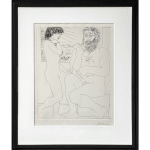




Pablo Picasso
'Sculpteur et Modèle Debout' Etching, 1933
Etching on paper
14 1/2 × 11 3/5 × 1/2 in
36.8 × 29.5 × 1.3 cm
36.8 × 29.5 × 1.3 cm
260
Hand signed in pencil, lower right.
Copyright The Artist
Further images
Pablo Picasso's 'Sculpteur et modèle debout' (1933), (which translates to 'Sculptor and Model Standing') is a striking example of his exploration of the human form and his innovative approach to...
Pablo Picasso's 'Sculpteur et modèle debout' (1933), (which translates to "Sculptor and Model Standing") is a striking example of his exploration of the human form and his innovative approach to both sculpture and painting. The work depicts a sculptor and his standing model, a theme Picasso frequently revisited throughout his career, engaging with both the act of creation and the relationship between the artist and the subject. The composition is dynamic and filled with tension, capturing a moment of artistic creation in the process. Picasso portrays the sculptor, with his back turned, as he works on his model, who stands in a contorted pose, revealing a raw, almost primal energy. The artist's treatment of the figures is highly abstract, with distorted proportions and geometric forms that break away from traditional representations of the human body. The model's figure, elongated and angular, interacts with the sculptor's posture and tools in a way that suggests a deep connection between creator and creation, as if the sculptor is in the act of both observing and transforming his model into an artwork. The background is minimal, drawing focus to the figures and their interaction. The work's color palette is muted, with earthy tones and subtle use of light and shadow, emphasizing the forms rather than creating a sense of place. Picasso’s ability to convey a sense of movement and tactile texture, even in a static representation, is evident in the way the sculptor's hands are poised and the model's stance suggests an implied action. This piece from 1933 is part of Picasso's broader interest in the dualities of life and art—creation and destruction, subject and object, reality and abstraction. It reflects the artist’s ongoing experiments with Cubism, Surrealism, and his desire to push the boundaries of artistic expression. Picasso's portrayal of the sculptor and his model is not just about the physicality of the figures but also an exploration of the emotional and psychological undercurrents of artistic creation. The etching is part of the Vollard Suite, a group of 100 etchings that Picasso created for Ambroise Vollard, a Parisian art dealer and publisher, between 1930 and 1937. The suite's main theme is the Sculptor's Studio, which reflects Picasso's engagement with classical sculpture at the time.
Picasso was a highly inventive artist who experimented with many techniques and materials, including collage, assemblage, and sculpture. He was a pioneer of Cubism, a revolutionary style that depicts abstracted forms from multiple viewpoints. Pablo Picasso’s most celebrated series of etchings, The Vollard Suite, comprises 100 etchings created by Picasso between 1930 and 1937, at a critical juncture in Picasso’s career. The etchings were made when Picasso was involved in a passionate affair with his muse and model, Marie-Thérèse Walter, whose classical features are a recurrent presence in the series. The predominant theme of the suite is the Sculptor’s Studio, which deals with Picasso’s engagement with classical sculpture. At this point he was making sculptures at his new home and studio, the Château de Boisgeloup outside Paris. The Vollard Suite takes its name from Ambroise Vollard (1866-1939), the greatest avant-garde Paris art dealer and publisher of his day, who gave Picasso his first Paris exhibition in 1901.
From the Suite Vollard (S.V. 68), edition of 260Signed by the artist in pencil, lower rightPrinted by Lacourière, 1939Published by Vollard, 1939(Bloch 177) (Baer 330.B.d)
Picasso was a highly inventive artist who experimented with many techniques and materials, including collage, assemblage, and sculpture. He was a pioneer of Cubism, a revolutionary style that depicts abstracted forms from multiple viewpoints. Pablo Picasso’s most celebrated series of etchings, The Vollard Suite, comprises 100 etchings created by Picasso between 1930 and 1937, at a critical juncture in Picasso’s career. The etchings were made when Picasso was involved in a passionate affair with his muse and model, Marie-Thérèse Walter, whose classical features are a recurrent presence in the series. The predominant theme of the suite is the Sculptor’s Studio, which deals with Picasso’s engagement with classical sculpture. At this point he was making sculptures at his new home and studio, the Château de Boisgeloup outside Paris. The Vollard Suite takes its name from Ambroise Vollard (1866-1939), the greatest avant-garde Paris art dealer and publisher of his day, who gave Picasso his first Paris exhibition in 1901.
From the Suite Vollard (S.V. 68), edition of 260Signed by the artist in pencil, lower rightPrinted by Lacourière, 1939Published by Vollard, 1939(Bloch 177) (Baer 330.B.d)




